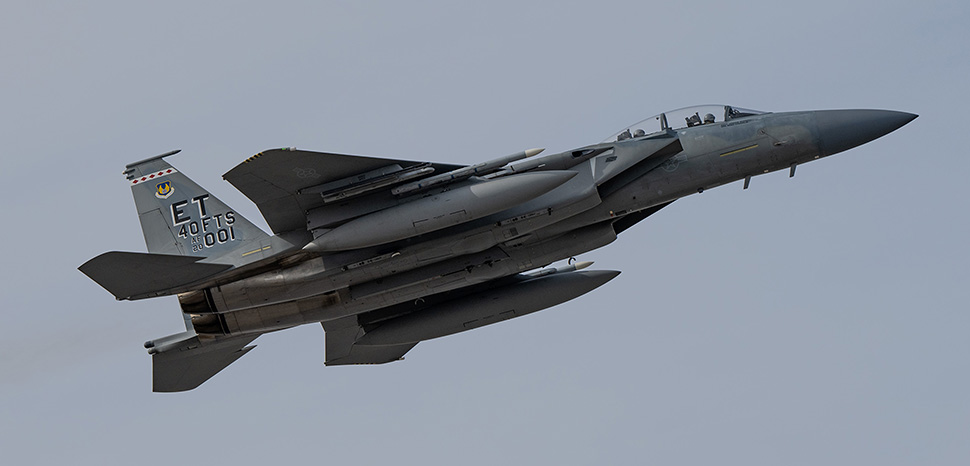David Wallace

Amidst Israel’s ongoing conflict in the Gaza Strip and concerns over an increased Iranian role in the war, reports are emerging that Israel may acquire the new F-15EX soon. Following Israel’s bombing of the Iranian Embassy in Syria, serious questions must be raised concerning the operational intentions Israel has for this aircraft. An analysis of the fixed-wing combat aircraft of Israel’s primary adversaries in the region and an analysis of the ranges of the existing Israeli Air Force further illustrates the F-15EX’s purpose – to be able to conduct deep strike operations in a contested air environment.
The F-15EX, like the F-15, is an air superiority fighter with limited ground attack capabilities. The F-15EX is the latest upgrade of Boeing and McDonnell Douglas’ F-15 multi-role strike fighter which entered service with the United States Air Force (USAF) in 1976. As a result of the termination of the F-22 production line, the 116th U.S. Congress decided to procure 144 F-15EXs to add more air superiority fighters to the USAF fleet. The F-15EX can carry 12 AIM-120 air-to-air missiles and has next-generation electronic warfare systems that serve to enhance the survivability of the aircraft by jamming adversary systems.

Source: Inventory data is derived from IISS Military Balance 2024 and aircraft age data is from Janes Defense
A survey of the capabilities of Israel’s main state adversaries, Iran and Syria, reveals that Israel does not face a modern fixed-wing threat that would justify the procurement of an advanced air superiority platform. The most advanced fixed-wing combat aircraft fielded by Iran and Syria is the Su-24MK – a tactical bomber introduced by the Soviet Union in the 1980s. The two Iranian aircraft produced in the new millennium are Yak-130 trainer aircraft whose combat credibility is speculative at best. Israel, a state that operates 39 F-35s as of February 2024, can-handedly defeat any Iranian or Syrian jet in an air-to-air engagement. As a result, the aerial threat environment does not provide a sufficient answer for Israel’s interest in the F-15EX. Rather, the combat range of the aircraft may provide some clues concerning Israeli interest in the F-15EX.

Source: The above figures are derived from Janes Defense. The combat range of an aircraft is generally determined by taking a third of the aircraft’s total range without factoring in aerial refueling as it is assumed that the operator will exhaust significant portions of fuel in combat operations before returning to base.
Factoring in Israel’s threat environment, any combat aircraft in the Israeli Air Force’s fleet can strike into Syria without aerial refueling. However, the Israeli Air Force cannot strike deep into Iran. Even from Israel’s closest airbase, the Ramat David Air Base, Israeli aircraft would have to fly approximately 948 miles to reach Tehran. The F-15EX comes closer than other aircraft by over a hundred miles but still falls short by about 150 miles.
However, efficient flight paths mixed with aerial refueling have enabled the Israeli Air Force to penetrate Iranian air space with the F-35 in the past. Though how far the Israeli F-35s went into Iran is unclear, a similar operation with F-15EXs could likely put several Iranian nuclear facilities in the crosshairs of Israeli pilots. Specifically, the Bushehr reactors and Rudan Nuclear Research Center in southern Iran could be easily reached by the F-15EX granted it received mid-air refueling as a component of a hypothetical strike operation.
Israel’s strike on April 4, 2024, on the Iranian Embassy in Syria with US-provided F-35s coincided with the Biden administration’s authorization to transfer F-35s to Israel. As a result, Iran perceives the United States as involved in the April 4 strike despite the operation being carried out by Israeli forces. As the world awaits the Iranian response, the United States, with several thousand personnel deployed in the Middle East, may find itself the victim of the consequences of an Israeli operation.
Arguments to arm Israel with the capability to strike Iran generally center around deterring Iranian aggression. Despite the deterrent value of possessing a capability designed to harm an adversary, the dynamics shift when a state is willing to exercise force with little regard for the consequences. International relations literature accepts the premise that the perceptions of an adversary are integral to establishing deterrence. In the adversary’s mind, there must be ambiguity regarding the state’s exercise of force to deter the adversary and not invite preemptive aggression.
In the Israeli-Iranian case, the current leadership in Israel has overtly called for aggressive actions against Iran for decades. Additionally, Israel has an established history of preventative strikes against regional adversaries. The rhetoric of the current Israeli leadership and the normalization of preventive strikes is enough evidence to raise concerns regarding Israeli intentions and lack of restraint.
Throughout Israel’s conflict in Gaza, the United States has been unable to effectively shape Israeli decision-making despite the measurable humanitarian and political implications of Washington’s failure to do so. Israel’s current leadership has thus far demonstrated itself to be inflexible and unwilling to cooperate with the United States’ regional interests. Israel’s stubbornness is especially surprising given the United States provides substantive defense material and security guarantees.
As long as these dynamics continue to define the US-Israeli relationship, the United States should not authorize the transfer of the F-15EX to Israel. Israel has repeatedly demonstrated its willingness to strike adversary targets in a manner that escalates tensions and puts US personnel at risk. Should Israel acquire the F-15EX, or any improvements to its combat aircraft’s operational range, there is no other mission than to be able to strike targets in Iranian territory. Should Israel acquire these capabilities, there is little indication to demonstrate that it will refrain from escalating tensions with Iran.
No comments:
Post a Comment